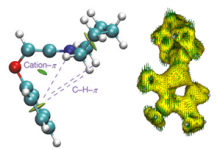Research
Methionine is one of the sulfur-containing amino acids found in proteins which is considered the most hydrophobic specie among the amino acids. Methionine is responsible for the protein synthesis, methylation of DNA and polyamine synthesis in human body. Deprivations of methionine can be used to reduce methionine both in plasma and tumor. Many investigators have attempted to exploit the methionine dependence of tumors for therapeutic effects in vivo. Since methionine free-diet is inefficient due to practical considerations, enzymatic degradation of methionine can be used as an... Read More
Metal catalysis allows different modes of activity in organic reactions and transition metal catalysis strategies are highly efficient. Also the effect of it in inverse electron demand Diels-Alder (IEDDA) reactions are important for the synthesis. The mode of action for the catalyst is fully revealed and its specific effect on the regioselectivity/specificity of the reaction is established. The silver-catalyzed IEDDA reactions of 1,2-diazines and siloxy alkynes were modeled to highlight the effect of the catalyst and its mode of action using Density Functional Theory (DFT).... Read More
Keteniminium salts are the cationic intermediates having higly electrophlilic, regioselective and and reactive nature. The keteniminium intermediates are highly functional for organic synthesis leading to formation of biologically activated compounds. These reactive intermediates are used in a broad range of reactions such as 6p/10p electrocyclization, inter/intramolecular [2+2] cycloaddition, Michael addition, Diels Alder and Pictet-Spengler reactions. By means of density functional theory (DFT) the reaction mechanisms are modeled and properties of keteniminium cations are investigated... Read More
During the times of fossil fuel shortage, as a result of increasing crude oil prices and environmental consequences sustainable energy forms become more and more the focus of attention. Hydropower, wind power, or biomass processing are some of the sustainable energy resources. Another important source for renewable energy is solar power. Photovoltaics and solar thermal collectors are some of the most widely used energy sources. Solar cells are mainly known as electric generating devices and their working mechanism is based on photo electrochemical processes. Dye solar cells (DSCs) are... Read More
In 1987, Tang and Von Slyke discovered organic light emitting diodes (OLEDs) which have great display qualities, thin and light structures. These OLED materials have improved applications in display and lighting technology. However, OLED devices have some insufficiencies which require further improvement. Economy and availability are the most important points in their applications. Synthesized OLEDs’ low device performances encouraged scientists to design a red color emitting OLED device by organometallic complexes. However, although the efficiency was increased up to maximum levels,... Read More
Today the therapeutic use of light has evolved particularly owing to the milestone discovery and application of photodynamic therapy (PDT).PDT is a noninvasive, less aggressive alternative approach for the cancer treatment which is based on the three criteria – molecular oxygen, activating light and a photosensitizer. PDT implies the excitation of the sensitizing drug by visible or IR light followed by the activation of molecular oxygen from the ground-state triplet to its singlet state.(1O2). Due to its high reactivity, 1O2 disrupts different biological macrosystems... Read More
Water nucleophilic attack (WNA) pathway is studied in recent years because of its increasing trend as a promising operative mechanism among Ru based water oxidation catalysts. Taking reference to this, complete WNA mechanism is investigated in order to understand full picture of metal catalysis in water oxidation. A key concern in this part of the study is to be able to have insight why two structurally similar mononuclear catalysts prefer different path (i.e. either WNA or I2M) for O-O bond formation in the catalytic cycle, and secondly, why Ru-bda has better catalytic activity than Ru-tpc.... Read More
Remarkable progress in the area of asymmetric organocatalysis has been achieved in the last decades. Cinchona alkaloids and their derivatives have emerged as powerful organocatalysts owing to their reactivities leading to high enantioselectivities. Cinchona alkaloids consist of pseudoenantiomeric pairs and induce high enantioselectivities in asymmetric processes. The asymmetric desymmetrization (AD) of meso-cyclic anhydrides catalyzed by pseudoenantiomeric pairs of cinchona alkaloids, quinine (QN) and quinidine (QD), has been investigated with Density Functional Theory (DFT) to... Read More









